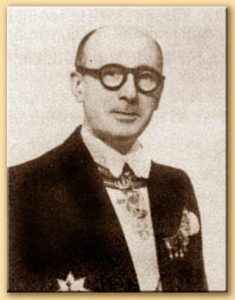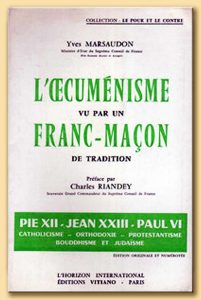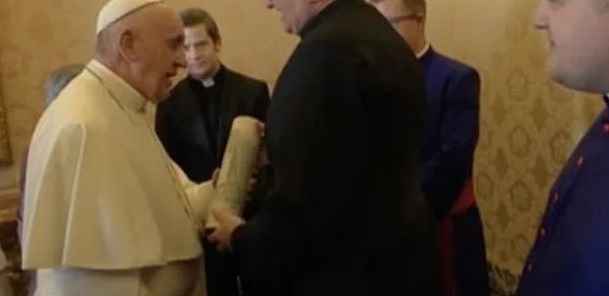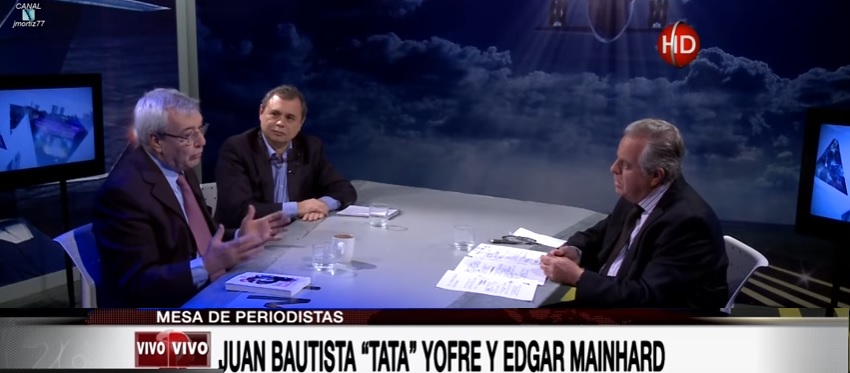By P. Paolo Maria Siano*
Wisdom. Strength. Beauty. The title of the dissertation by Monsignor Michael Heinrich Weninger, of which I have already written here, is on the reconciliation of the Catholic Church and regular Freemasonry (Tesi Gregoriana – Series Spirituality, GBP, Rome 2019, p. 523). Now I present and comment on some points of this doctoral thesis, which is taken entirely for the regular English (United Grand Lodge of England, UGLE) and Anglophile Freemasonry (e.g. the Grand Lodge of Austria, GLvÖ). Monsignor Weninger reveals an interesting background:
When the then Rector of the Pontifical Gregorian University (P. Francois-Xavier Dumortier, 2010–2016) learned that Monsignor Weninger was preparing a book on Freemasonry, he suggested that he come to the Gregoriana as a doctoral student and submit his work as a dissertation at the Institute of Spirituality (p. 5).
Cui prodest? Who benefits?
Monsignor Weninger thanks high dignitaries of the Grand Lodge of Austria (GLvÖ) and the United Grand Lodge of Germany (VGLvD), who have enabled him to consult material for his research. Among these, I would like to refer only to Michael Kraus ("M.K."), former Grand Master of the GLvÖ, Georg Semler ("G.M."), current Grand Master of the GLvÖ, and Christoph Bosbach ("C.B."), Grand Master of the VGLvD. He also thanks Cardinal Jean-Louis Tauran for accompanying his work and the spiritual confreres who are also brothers in Freemasonry (p. 5-6). Monsignor Weninger does not explicitly disclose his Masonic membership, which was published on an English Masonic website back in 2014.
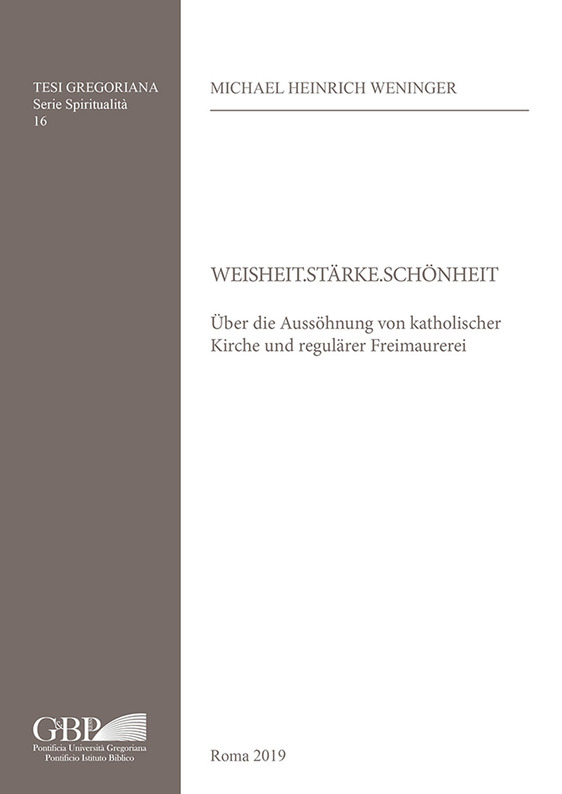
Monsignor Weninger asserts the compatibility of the Church and regular Freemasonry against what he calls prejudices and misunderstandings. He considers that the Church was unable to distinguish between regular and irregular Freemasonry (p. 8-9); he wants to show ("objectively") that there are foundations for a complete reconciliation between the Church and regular Freemasonry (p. 10, pp. 451-453); true regular Freemasonry which is of the three degrees (p. 14) such as the UGLE and the GLvÖ; Freemasonry is not a secret society, its rituals are known (p. 27) and have nothing to do with satanic, alchemical, magical or esoteric rites (p. 28, p. 63); and finally Freemasonry is neither a religion nor a religious community and has no dogmas (p. 436).
These statements do not convince me.
Unfortunately, Monsignor Weninger does not publish the rituals of the Grand Lodge of Austria in the appendix, nor does he explain them in more detail. Apart from that, the fact that he published his doctoral thesis at the Institute of Spirituality (and not at the Institute of History) suggests that Freemasonry is after all a form of spirituality. This, in turn, reveals something of the intrinsical relationship between regular Freemasonry-esoteric magic, which the author tries in vain to deny or at least minimize. Nevertheless, he leaves some clues here and there, when he admits, for example:
- The Masonic ritual makes the inner transformation of man experimental and gives no religious or confessional teaching (p. 30).
- The Masonic Mystery is the individual and ritual experience of the Freemason in the Masonic Temple (p. 31-32).
- Symbolically, the Masonic Lodge extends from east to west, from north to south, from the earth to the sky and from the earth's surface to its center (p. 33).
Well, the center of the earth.
Then Monsignor Weninger explains that the Freemason frees himself from the profane world in the ritual and enters the holy place ("into a fanum", p. 33). Every Freemason sees in the formula of the Great Builder of the Universe, the name by which the Freemasons call God, the God of his religion (p. 33, p. 42). From a metaphysical point of view, I observe that the Freemason can contribute through its rituals (as Monsignor Weninger leads us to understand) to the perfection of humanity and to the harmony and preservation of the universe (p. 33) and thus perform sectarian service or of divine or demiurgic (gnotic) action within an initiating, symbolic, symbolic, symbolic framework. Masonic magic?
Monsignor Weninger presents the three degrees from an anthropological point of view as symbolic stages of the improvement of man between brothers and in the world (p. 35–37) and admits that Kant's Enlightenment has to this day influenced the philosophical foundations of The Masonic self-image (p. 84) and that there are Freemasons (also from the GLvÖ) who regard Freemasonry as a daughter of the Enlightenment (p. 85).

The Author Doesn't Succeed in Convincing
If these were true, we would have the paradox that the Catholic Freemason (even a priest) would not conjure if he worked in the Lodge ("The Brotherhood of the Freemasons, on the other hand, knows no magical rituals, it does not practice magic, just as occultism has no place in Masonic work", p. 113), but he would conjure if he participated in special rites or blessings of the Catholic Church (or celebrates if he is a priest)! This is an example of the reversal and unification of opposites that fascinates initiatic circles. Weninger affirms that Masonic rituals "shape a spiritual, intellectual identity, not a free or occult one" (p. 114); that the Masonic initiation is simply the admission of a candidate to Freemasonry and does not refer to the ancient mysteries and has no religious or mystical meaning, although some Freemasons (here the author Quotes G. Imhof, Kleine Werklehre) are convinced of this (p. 178).
Later in the book, the author denies that the Masonic constitutions of Anderson (1723) contain religious relativism or indifferentism (p. 240).
I repeat, on the other hand, that the initiation ritual and the super-confessional religiosity of Freemasonry together represent a special form of magic: the Masonic rites (e.g. enlightenment, death-rebirth) with symbols and invocations to the Great Builder of the Universe (in which every Freemason sees the God of his religious or initiatical "confession") for the purpose of personal communion and universalness, which were neither revealed by the biblical God nor confirmed or proposed by the Catholic tradition (dogmatic, doctrinaire, liturgical and canonical). It is the claim, as in the biblical narrative of the tower building at Babel, which is not by chance at least implicitly praised by English Freemasons of the early 18th century to ascend to heaven. In addition, regular Freemasons, including the German-speaking area, testify to the illuminator and esoteric nature of Freemasonry and make it clear that Freemason mysticism encompasses those "sciences" and "traditions" (hermetics, kabbalah, magic ...) from which Weninger tries to relieve pure Freemasonry. Finally, I am convinced that among the sources of regular Freemasonry cited by the author (p. 497–498) there are some (which are withheld from us "uninitiated") which contain the deeper reasons for the incompatibility between church and Freemasonry.
* Father Paolo Maria Siano is a member of the Order of the Franciscans of the Immaculate (FFI); the doctor of the Church is considered one of the best Catholic connoisseurs of Freemasonry, to whom he has dedicated several standard works and numerous essays. Katholisches.info published by him:
- Brother." Peter Stiegnitz of the Grand Lodge of Austria (1936-2017)
- The "Fall Weninger" – ex-diplomat, priest, kurialer, Freemason
the Freemasonry explained by a Grand Master - The knockers can expect initiation and gnosis at the Masonic League
- Baron Yves Marsaudon - A High-Level Mason in the Order of Malta
- The Lodge Quatuor Coronati, the Grand Master and a Beggar Brother
- "Catholic who joins Lodge is excommunicated" – Church historian Paolo Siano on church and Freemasonry
- Short answer to a Grand Master of Freemasonry
- Was Karl Rahner A Freemason?
translation: Giuseppe
Nardi Picture: Catholic Church Carinthia/Freemason Wiki (Screenshots)
Trans: Tancred vekron99@hotmail.com
AMDG
Nardi Picture: Catholic Church Carinthia/Freemason Wiki (Screenshots)
Trans: Tancred vekron99@hotmail.com
AMDG



